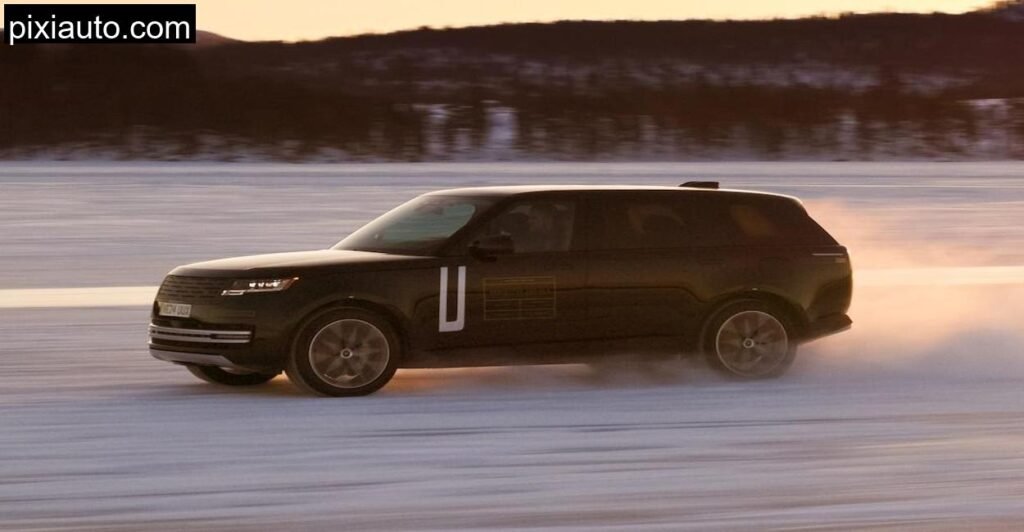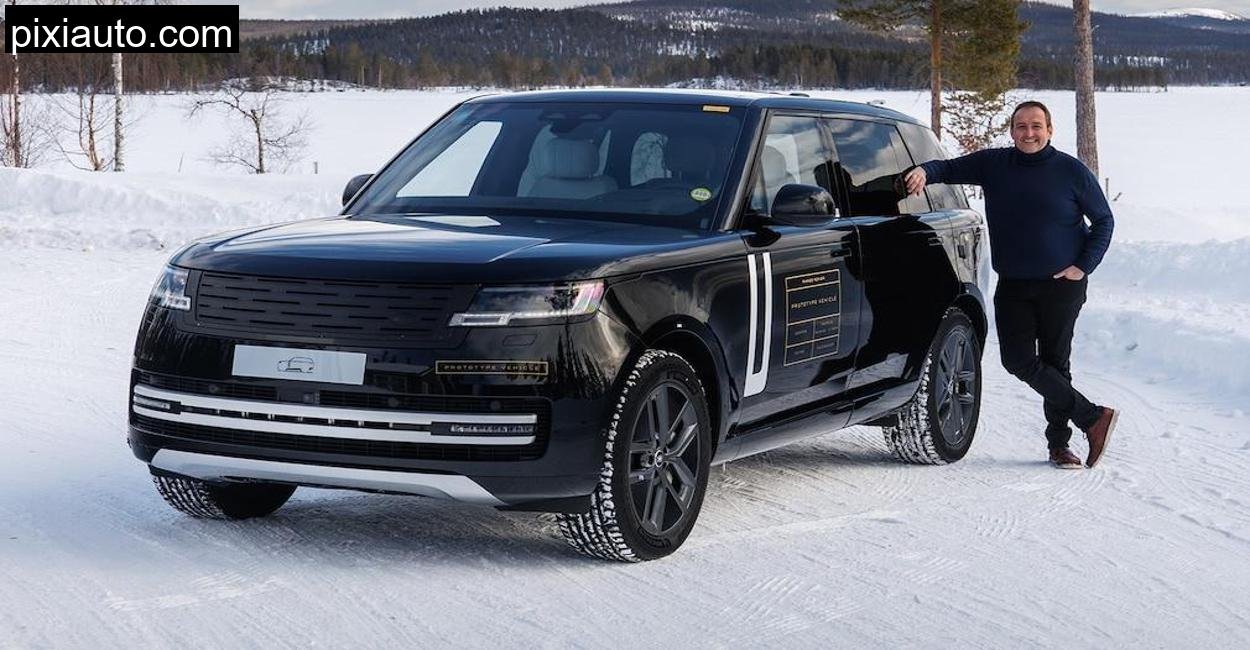The Harrl is not the Alps, but when spring lingers and the forest trails are still damp with melting snow and echoing silence, it can feel just as wild and untamed. And that’s exactly what I needed for what might be the most important first drive of the year, the prototype of the Range Rover Electric. The SUV that isn’t just going electric, but doing it on its own terms, quietly, luxuriously, and without losing its off, road soul.
The Deister’s southern sibling offered just the right balance: soft forest mud, rocky climbs, slippery gravel paths, and the kind of trail serenity that makes you appreciate silence. And silence is the Range Rover Electric’s new language.
Because this isn’t just another SUV with a battery. This is a luxury off, roader built for the kind of people who think nothing of gliding from a London townhouse to a Scottish hunting lodge. And now, they can do that wrapped in a cocoon of electric calm.
A Range Rover That Doesn’t Roar, It Glides
The first thing that struck me as I pushed the gear selector into Drive was not the absence of noise, but the absence of drama. No rumble, no roar, not even the faint hum some EVs use to signal motion. The Range Rover Electric prototype moved like a ghost through the Harrl forest, noiseless, effortless, composed. Just a faint whisper from the tires rolling over damp twigs and loose stones.
And when I say composed, I mean stately. The air suspension hovers the body like it’s riding its own invisible rail system. That newfound center of gravity, thanks to a 117 kWh battery slab underneath, anchors the car to the earth like it belongs to it. The ride isn’t just smooth; it’s regal. It turns rough forest tracks into freshly paved estate roads.
But don’t let the quiet fool you. Underneath that stoic skin, this thing is all muscle.
Muscle Wrapped in Silk: Electric Powertrain Performance
With 550 horsepower and 850 Nm of torque, it doesn’t just move, it lunges if you want it to. Two electric motors, one on each axle, coordinate to deliver permanent all, wheel drive. The power is instant, always ready, and frighteningly smooth. It’s like the car reads your mind before you touch the throttle.
Climbing a rocky incline near the Harrl tower, with one wheel in the air and another on slippery leaves, I let off the brake and held the throttle steady. No wheelspin. No delay. Just precise torque distribution, a gentle push, and the car calmly crested the slope like it had done it a thousand times.
Land Rover’s engineers weren’t bluffing, off, road, the electric drivetrain doesn’t just compete with the old diesel or petrol V8s, it redefines what calm dominance looks like. No revs to build, no turbo lag, no gear hunting. It just pulls.
Brain Over Brawn: Software That Thinks Before You Slide
What makes it all click is not just the hardware. It’s the software that predicts your next mistake. The traction control, torque vectoring, and off, road algorithms are working harder than I could imagine. On one tricky descent with alternating patches of dry gravel and moist clay, I experimented with one, pedal driving. It felt like having an expert spotter controlling each wheel independently, braking just enough, never locking up, never lurching.
The smart off, road cruise control, which Land Rover has refined for this electric drivetrain, handled even the steepest declines with eerie confidence. It felt surreal letting the car manage itself so precisely on terrain where I’d normally be riding the brake and praying.
And the 800, volt system behind it all? Cool, calm, and charging like a Porsche Taycan. Literally.
Real Range, Real Road Manners

Land Rover promises “well over 500 kilometers” of range, and while we weren’t able to push the prototype to its limit on this short test route, the early numbers are promising. In mixed driving through forest paths, village roads, and a fast Autobahn burst (yes, we took the long route home), consumption hovered around 23.4 kWh/100 km, very reasonable for a nearly three, ton luxury barge.
Back on tarmac, the Range Rover doesn’t try to mimic sports cars like some electric SUVs. It still rolls like a Range should, heavy, commanding, but never clumsy. The weight is there, but so is the balance. The instant torque fills the gaps left by the absence of turbocharged revs, and the steering, although light, feels planted.
Passing tractors or merging onto the B65 was a joke, blink and you’re at 120 km/h. The prototype, although unfinished, felt incredibly refined. And whisper, quiet even at those speeds. The thick glass, insulated cabin, and absence of engine noise make it more silent than a cathedral at midnight.
Not Just an Electric Conversion, It’s a Rebirth
Some might scoff at the fact that the Range Rover Electric doesn’t ride on a dedicated EV platform. That there’s no frunk. That the floor height still caters to ICE legacy components. But they’re missing the point.
This isn’t a tech, first Tesla. It’s not here to impress Silicon Valley. It’s here to do everything the Range Rover already does, but better and quieter.
Fording depth? Still impressive. Ground clearance? Adjustable as ever. Towing? Of course. And luxury? More than ever. Every surface inside was already finished like a five, star hotel lounge. Now add electric silence, zero vibration, and no gear hunting. You get a kind of rolling meditation suite.
Technical Specifications
We rely solely on Range rover’s official website for the most accurate and dependable technical data.
| Specification | Detail |
| Powertrain | Dual Motor AWD |
| Total Power Output | 550 hp |
| Torque | 850 Nm |
| Battery Capacity | 117 kWh (800, volt architecture) |
| Charging (AC) | Up to 22 kW |
| Charging (DC) | Up to 350 kW |
| Estimated Range | Over 500 km |
| 0, 100 km/h | Approx. 5 seconds (est.) |
| Off, Road Systems | Terrain Response, Smart Cruise |
| Suspension | Adaptive Air Suspension |
| Platform | MLA Flex (Modified for EV) |
| Fording Depth | Over 900 mm |
| Towing Capacity (est.) | Over 3,000 kg |
| Weight | Approx. 2,900, 3,000 kg |
Conclusion: The Electric Nobleman Has Arrived
Driving the Range Rover Electric prototype through the Harrl forest didn’t just change how I see off, road EVs, it changed how I feel about luxury altogether. It wasn’t a compromise. It wasn’t an experiment. It was a Range Rover first, and an electric car second, exactly how Land Rover wants it.
It preserves everything that makes the Range what it is: the poised ride, the commanding posture, the interior worthy of a penthouse suite. And now it adds silence, instant torque, cleaner conscience, and near, magical traction on every surface.
If this is what the future of luxury SUVs looks like, then we’re not just stepping into a new chapter, we’re floating into it.
When will the Range Rover Electric go on sale?
The production model is expected to launch by the end of 2025.
Is Range Rover Electric based on a dedicated EV platform?
No, it uses a heavily modified MLA Flex architecture, also used for hybrid models.
How does Range Rover Electric compare to rivals like the BMW iX or Mercedes EQS SUV?
The Range Rover Electric offers more off, road capability, a richer ride feel, and arguably a more regal interior. It’s also significantly more powerful than most competitors in this category.



Leave a Comment